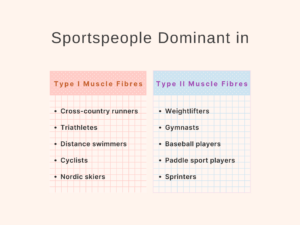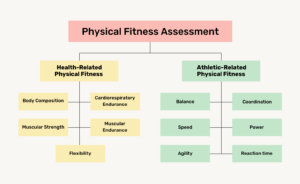Table of Contents
Your fitness goals may require a focus on different elements, including strength, power, and speed. These elements, or fitness components, fall into two groups: health-related and athletic-related. Health-related components, as the name implies, are essential for everyone and include strength, muscular endurance, cardio-respiratory endurance, body composition, and flexibility. On the other hand, athletic-related components, such as speed, power, agility, coordination, and reaction time, are particularly relevant to athletes.
Keep in mind that this classification of fitness elements may not always hold true in every situation, but it serves as a useful guideline for individuals to determine which elements align with their fitness objectives.
With this understanding of how fitness elements are categorised, let’s now explore the specific details of strength, speed, and power.
Strength
Strength refers to your body’s capacity to generate force against resistance, as seen in actions like lifting or pushing heavy objects. Given its essential role in your physical well-being, maintaining and enhancing strength should be a key component of your exercise routine. Indeed, building optimal strength is essential for numerous daily activities.
Building strength requires performing movements like lifting, pushing, pulling, or throwing an object for a limited number of sets and repetitions. For example, you can develop strength through weightlifting or bodyweight exercises such as the deadlift, handstand pushup, bench press, squat, shoulder press, and so on.
Who’s stronger?
To determine relative strength, imagine a situation where you can effortlessly lift a heavy piece of furniture and move it up a flight of stairs, whereas your friend, who has a similar body weight as you, struggles with the same task. In this scenario, being capable of moving the furniture with ease demonstrates greater strength. Furthermore, if one individual can complete five repetitions of a 120 kg barbell deadlift while another can only accomplish one repetition, the former exhibits superior strength, assuming their body weights are equal.
It’s important to note that, when assessing strength in the weight room, the number of reps is typically low, usually ranging from 1 to 6, with the emphasis on maximum force output.
Speed
Speed refers to the ability to move quickly and efficiently from one point to another, whether it’s through running, cycling, or other forms of motion. In sports such as track and field, football, and tennis, where rapid movements are crucial, speed is of paramount importance.
Speed is an athletic-related fitness element that can be enhanced through specific training techniques. Its training, indeed, involves a variety of drills, sprinting, agility exercises, and specific techniques designed to increase stride length, efficiency, and frequency.
Who possesses greater speed?
Consider a scenario in which one person completes a 100-metre run in 15 seconds while another requires 18 seconds for the same distance. In this case, the individual who finishes the run in a shorter time is the faster one. When assessing speed, two key elements come into play: time and distance.
Power
Power refers to the rapid generation of force by combining elements of speed and strength. While strength focuses on maximum force output, power involves quick force production. Both speed and power fall within the domain of athletic-related fitness components.
In sports, power is essential for explosive movements such as jumping, sprinting, or throwing. Athletes in sports like sprinting and basketball heavily rely on power. Developing power often involves training methods that emphasise both strength and speed, including plyometric exercises and Olympic weightlifting.
Please note that for many individuals, prioritising improvements in strength, muscular endurance, flexibility, lean body mass, and cardiorespiratory endurance is often more significant than enhancing speed and power.
Who possesses greater power?
To assess relative power, consider a scenario where one of your friends can complete a 120 kg barbell bench press with one repetition in just one second, while another friend, who shares a similar body weight, takes 1.5 seconds to perform the same exercise. In this instance, the friend who completes the exercise in a shorter time is considered more powerful.
In general, when evaluating power, factors like strength (maximum force output) combined with speed are the primary considerations.”
Summary
Grasping the differences between strength, speed, and power is essential for tailoring your fitness journey. Strength centres on maximum force output; speed relates to swift movement over a distance; and power combines both speed and strength for explosive actions. Whether your fitness objectives are health-related or athletic-related, a solid understanding of these components will steer you towards a healthier and more athletic you.
I hope you approach your training routines without the pursuit of competition at any level. Competition leads to unnecessary challenges and stressors that are detrimental to health, both physically and psychologically. Instead, prioritising a fitness journey that promotes well-being in every aspect of life is wise.
Frequently Asked Questions
-
What are the key components of physical fitness?
Physical fitness includes both health-related and athletic-related components. Health-related components consist of strength, muscular endurance, cardio-respiratory endurance, body composition, and flexibility. Athletic-related components include speed, power, agility, coordination, and reaction time.
-
What is the definition of strength in fitness?
Strength in fitness refers to the body’s capacity to generate force against resistance, such as lifting or pushing heavy objects. It is typically measured in pounds or kilogrammes and is a key component of health-related fitness.
-
How can I build strength in my fitness routine?
You can build strength through exercises like weightlifting or bodyweight workouts, using the right number of sets, repetitions, and appropriate weights. Strength training is essential for various daily activities.
-
How is speed defined in the context of fitness?
Speed in fitness refers to the ability to move quickly and efficiently from one point to another. It’s crucial in sports like track and field, football, and tennis. Speed training includes drills, sprinting, agility exercises, and techniques to improve stride length and frequency.
-
What is the difference between speed and power in fitness?
Speed focuses on moving quickly over a distance, while power combines elements of speed and strength, involving rapid force generation. Strength is an essential component of health-related fitness, while power and speed are more relevant to athletic-related fitness.
-
6. How can I develop power in my fitness routine?
Developing power involves training methods that emphasise both strength and speed. Plyometric exercises and Olympic weightlifting are common approaches to enhancing power. Power is essential for explosive movements in sports like sprinting, basketball, and boxing.




